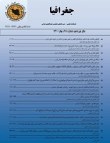Systematic analysis of the political division of space in Iran
Achieving social justice and development is one of the most important concerns of developing countries today. Whereas how the political organization of space affects the realization or non-realization of social justice; Therefore, the ruling political system in order to better manage its territory, to establish maximum coordination and efficiency based on various geographical, political, economic, social, cultural elements and in order to facilitate the sovereignty of the government to the lowest political levels in the country, uses the tools of political organization of space. In the meantime, it should be noted that the division of the country as one of the most important tools of political organization of space, for better management and greater use of regional talents. In other words, the realistic application of divisions of the country based on scientific principles and spatial needs is done with the two objectives of optimizing places and optimizing functions and activities, ultimately, it will fertilize internal-place capacities and achieve local, national and regional development.Now, due to the existence of unbalanced natural conditions, lack of uniform distribution of vital resources, the existence of a centralized government system that has led to a lack of optimal distribution of population and facilities in Iran; It should be noted that wrong decisions related to the geographical space of the country can lead to the emergence of various challenging factors in the interests of the country. In the meantime, recognizing how the elements and factors affecting the political division of Iranian space with the aim of gaining a realistic and comprehensive view in this field, to address the challenges to achieve the goals of political division of space is essential. Therefore, during the present study, we intend to determine the impact of elements and factors such as the form of government, ecological minorities, geography of power and support, etc. on the division of space in Iran, and finally through systematic analysis with the presentation of the model to evaluate the role of factors and elements affecting the political division of Iranian space and its consequences.
Therefore, the present study was conducted to identify and prioritize the factors affecting the political division of space in Iran in the form of systemic thinking in a descriptive-analytical manner, in terms of applied results and with an exploratory purpose. Therefore, at first, the factors affecting the political division of space in Iran were determined through library studies, and then to determine the importance of each component in the political division of space, a quantitatively and specifically researcher-made questionnaire was used, which is based on the Likert scale of one (very low) to five (very high) rated. The reliability of the questionnaire was determined through Cronbach's alpha. If the Cronbach's alpha coefficient is calculated for a scale greater than 0.7, the reliability of that scale is considered desirable. Cronbach's alpha coefficient in this study was calculated to be 0.71. Therefore, the reliability of the questionnaire has been evaluated as desirable and its validity has been confirmed by the judgment of experts as well as full coverage of theoretical foundations. Friedman inferential test has also been used to prioritize the impact of each component on the political division of space. A small sample of 30 experts related to the subject was considered and finally the result was modeled and reviewed based on systemic thinking through Vensim software.
Based on this model, we finally found that the form of government with a rank of 10.3, informal factors with a rank of 9.8 (which include the influence of supra-regional powers, parliamentarians, imams, government institutions, Islamic councils) and the population with a rank of 9, are the most effective components in the political division of the Iranian space.
Also, in the Law of national divisions approved by 62, the basis of unification is mainly considered as a single criterion and based on population; It is obvious that considering such incomplete bases for Iran's geographical spaces, in which the topographic structure is heterogeneous and the pattern of population distribution and resources is unbalanced, will result in the emergence of various functional and physical challenges in the political division of Iranian space. Therefor amending and clarifying the law of division of the country with an unchangeable executive mechanism in such a way that no intervention by power agents is possible, while considering a multi-criteria model to achieve a more balanced pattern of space divisions, fertilization of internal-place capacities and finally achieving local, national and regional development is essential.
- حق عضویت دریافتی صرف حمایت از نشریات عضو و نگهداری، تکمیل و توسعه مگیران میشود.
- پرداخت حق اشتراک و دانلود مقالات اجازه بازنشر آن در سایر رسانههای چاپی و دیجیتال را به کاربر نمیدهد.


